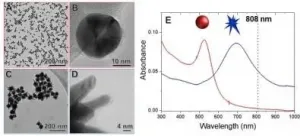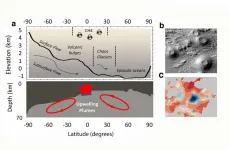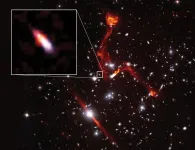How sperm remember
Discovery identifies non-DNA mechanism involved in transmitting paternal experience to offspring
2021-03-16
(Press-News.org) It has long been understood that a parent's DNA is the principal determinant of health and disease in offspring. Yet inheritance via DNA is only part of the story; a father's lifestyle such as diet, being overweight and stress levels have been linked to health consequences for his offspring. This occurs through the epigenome - heritable biochemical marks associated with the DNA and proteins that bind it. But how the information is transmitted at fertilization along with the exact mechanisms and molecules in sperm that are involved in this process has been unclear until now.
A new study from McGill, published recently in Developmental Cell, has made a significant advance in the field by identifying how environmental information is transmitted by non-DNA molecules in the sperm. It is a discovery that advances scientific understanding of the heredity of paternal life experiences and potentially opens new avenues for studying disease transmission and prevention.
A paradigm shift in understanding of heredity
"The big breakthrough with this study is that it has identified a non-DNA based means by which sperm remember a father's environment (diet) and transmit that information to the embryo," says Sarah Kimmins, PhD, the senior author on the study and the Canada Research Chair in Epigenetics, Reproduction and Development. The paper builds on 15 years of research from her group. "It is remarkable, as it presents a major shift from what is known about heritability and disease from being solely DNA-based, to one that now includes sperm proteins. This study opens the door to the possibility that the key to understanding and preventing certain diseases could involve proteins in sperm."
"When we first started seeing the results, it was exciting, because no one has been able to track how those heritable environmental signatures are transmitted from the sperm to the embryo before," adds PhD candidate Ariane Lismer, the first author on the paper. "It was especially rewarding because it was very challenging to work at the molecular level of the embryo, just because you have so few cells available for epigenomic analysis. It is only thanks to new technology and epigenetic tools that we were able to arrive at these results."
Changes in sperm proteins affect offspring
To determine how information that affects development gets passed on to embryos, the researchers manipulated the sperm epigenome by feeding male mice a folate deficient diet and then tracing the effects on particular groups of molecules in proteins associated with DNA.
They found that diet-induced changes to a certain group of molecules (methyl groups), associated with histone proteins, (which are critical in packing DNA into cells), led to alterations in gene expression in embryos and birth defects of the spine and skull. What was remarkable was that the changes to the methyl groups on the histones in sperm were transmitted at fertilization and remained in the developing embryo.
"Our next steps will be to determine if these harmful changes induced in the sperm proteins (histones) can be repaired. We have exciting new work that suggest that this is indeed the case," adds Kimmins. "The hope offered by this work is that by expanding our understanding of what is inherited beyond just the DNA, there are now potentially new avenues for disease prevention which will lead to healthier children and adults."
INFORMATION:
To read: "Histone H3 lysine 4 trimethylation in sperm is transmitted to the embryo and associated with diet-induced phenotypes in the offspring" by Ariane Lismer et al in Developmental Cell
https://doi.org/10.1016/j.devcel.2021.01.01
The research was funded by the Canadian Institute of Health Research
About McGill University
Founded in Montreal, Quebec, in 1821, McGill University is Canada's top ranked medical doctoral university. McGill is consistently ranked as one of the top universities, both nationally and internationally. It is a world-renowned institution of higher learning with research activities spanning two campuses, 11 faculties, 13 professional schools, 300 programs of study and over 40,000 students, including more than 10,200 graduate students. McGill attracts students from over 150 countries around the world, its 12,800 international students making up 31% of the student body. Over half of McGill students claim a first language other than English, including approximately 19% of our students who say French is their mother tongue.
Contact:
Katherine Gombay
McGill Media Relations Office
1-514-717-2289
katherine.gombay@mcgill.ca
http://www.mcgill.ca/newsroom/
http://twitter.com/McGillU
ELSE PRESS RELEASES FROM THIS DATE:
2021-03-16
Lightning strikes -- perhaps a quintillion of them, occurring over a billion years -- may have provided sparks of life for the early Earth.
A new study by researchers at Yale and the University of Leeds contends that over time, these bolts from the blue unlocked the phosphorus necessary for the creation of biomolecules that would be the basis of life on the planet.
"This work helps us understand how life may have formed on Earth and how it could still be forming on other, Earth-like planets," said lead author Benjamin Hess, a graduate student in Yale's Department of Earth & Planetary ...
2021-03-16
Lightning strikes were just as important as meteorites in creating the perfect conditions for life to emerge on Earth, geologists say.
Minerals delivered to Earth in meteorites more than 4 billion years ago have long been advocated as key ingredients for the development of life on our planet.
Scientists believed minimal amounts of these minerals were also brought to early Earth through billions of lightning strikes.
But now researchers from the University of Leeds have established that lightning strikes were just as significant as meteorites in performing this essential function and allowing life to manifest.
They say this shows that life could develop on Earth-like planets through the same mechanism at any time if atmospheric conditions are right. The research ...
2021-03-16
The activity of enzymes in industrial processes, laboratories, and living beings can be remotely controlled using light. This requires their immobilization on the surface of nanoparticles and irradiation with a laser. Near-infrared light can penetrate living tissue without damaging it. The nanoparticles absorb the energy of the radiation and release it back in the form of heat or electronic effects, triggering or intensifying the enzymes' catalytic activity. This configures a new field of study known as plasmonic biocatalysis.
Research conducted at the University of São Paulo's Chemistry Institute (IQ-USP) in Brazil investigated the activity of enzymes immobilized on gold ...
2021-03-16
FLAGSTAFF, Ariz. -- March 16, 2021 -- The findings of a recent analysis conducted by the Translational Genomics Research Institute (TGen), an affiliate of City of Hope, suggest that ecosystems suitable for harboring ticks that carry debilitating Lyme disease could be more widespread than previously thought in California, Oregon and Washington.
Bolstering the research were the efforts of an army of "citizen scientists" who collected and submitted 18,881 ticks over nearly three years through the Free Tick Testing Program created by the Bay Area Lyme Foundation, which funded the research, producing a wealth of data for scientists to analyze.
This new study builds on initial research led by the ...
2021-03-16
March 16, 2021, Mountain View, CA - In a comment published today in Nature Astronomy, Dr. Nathalie Cabrol, Director of the Carl Sagan Center for Research at the SETI Institute, challenges assumptions about the possibility of modern life on Mars held by many in the scientific community.
As the Perseverance rover embarks on a journey to seek signs of ancient life in the 3.7 billion years old Jezero crater, Cabrol theorizes that not only life could still be present on Mars today, but it could also be much more widespread and accessible than previously believed. Her conclusions are based on years of exploration of early Mars analogs in extreme environments in the Chilean altiplano and the Andes funded ...
2021-03-16
Billions of years ago, the Red Planet was far more blue; according to evidence still found on the surface, abundant water flowed across Mars and forming pools, lakes, and deep oceans. The question, then, is where did all that water go?
The answer: nowhere. According to new research from Caltech and JPL, a significant portion of Mars's water--between 30 and 99 percent--is trapped within minerals in the planet's crust. The research challenges the current theory that the Red Planet's water escaped into space.
The Caltech/JPL team found that around four billion years ago, Mars was home to enough water to have covered the whole planet in an ocean about 100 to 1,500 meters deep; a volume roughly ...
2021-03-16
URBANA, Ill. - Corn didn't start out as the powerhouse crop it is today. No, for most of the thousands of years it was undergoing domestication and improvement, corn grew humbly within the limits of what the environment and smallholder farmers could provide.
For its fertilizer needs, early corn made friends with nitrogen-fixing soil microbes by leaking an enticing sugary cocktail from its roots. The genetic recipe for this cocktail was handed down from parent to offspring to ensure just the right microbes came out to play.
But then the Green Revolution changed everything. Breeding tools improved dramatically, leading to faster-growing, higher-yielding hybrids than the world had ...
2021-03-16
Radio telescopes are the world's most sensitive radio receivers, capable of finding extremely faint wisps of radio emission coming from objects at the farthest reaches of the universe. Recently, a team of astronomers used the National Science Foundation's Karl G. Jansky Very Large Array (VLA) to take advantage of a helping hand from nature to detect a distant galaxy that likely is the faintest radio-emitting object yet found.
The discovery was part of the VLA Frontier Fields Legacy Survey, led by NRAO Astronomer Eric Murphy, which used distant clusters of galaxies as natural lenses ...
2021-03-16
Recent research shows that people are more likely to take "microbreaks" at work on days when they're tired - but that's not a bad thing. The researchers found microbreaks seem to help tired employees bounce back from their morning fatigue and engage with their work better over the course of the day.
At issue are microbreaks, which are short, voluntary and impromptu respites in the workday. Microbreaks include discretionary activities such as having a snack, chatting with a colleague, stretching or working on a crossword puzzle.
"A microbreak is, by definition, short," says Sophia Cho, co-author of a paper on the work and an assistant professor ...
2021-03-16
RESEARCH TRIANGLE PARK, N.C. -- Joint Army- and Air Force-funded researchers have taken a step toward building a fault-tolerant quantum computer, which could provide enhanced data processing capabilities.
Quantum computing has the potential to deliver new computing capabilities for how the Army plans to fight and win in what it calls multi-domain operations. It may also advance materials discovery, artificial intelligence, biochemical engineering and many other disciplines needed for the future military; however, because qubits, the fundamental building blocks of quantum computers, are intrinsically fragile, a longstanding barrier to quantum computing has been effective implementation of quantum error correction.
Researchers at University of Massachusetts Amherst, ...
LAST 30 PRESS RELEASES:
[Press-News.org] How sperm remember
Discovery identifies non-DNA mechanism involved in transmitting paternal experience to offspring




